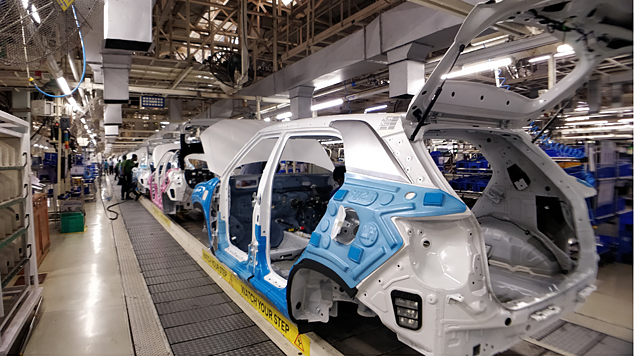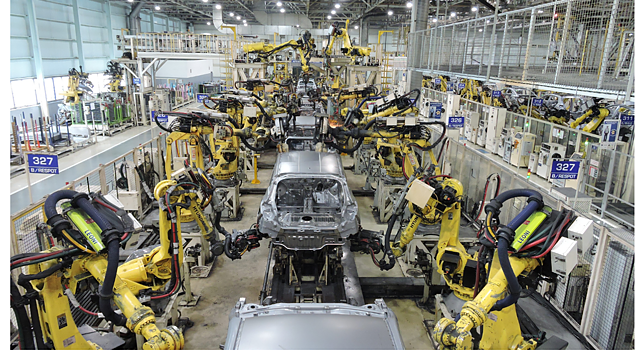
Hyundai Motor India (HMI) has been progressing well ever since it began its operations a quarter-century ago in India with its plants in Irrungattukottai, near Chennai. Despite the company growing on several aspects, including the number of models and volumes, it ensures that its manufacturing quality does not dwindle; instead, it keeps growing with the times.
HMI has two plants on the same campus, established in 1998 and 2007. During the past decade, both the plants have been augmented for capacity enhancements at different intervals. This was possible as the assembly lines were initially designed for flexibility in augmentation and expansion to future requirements.
The body shop is designed based on Hyundai Group's global bodyline concepts, which enabled HMI to enhance volumes and increase the number of models, perhaps to get assembled in a single line. The company could manoeuvre three or four models about seven years ago from a single line, which is now increased to six models. The number of units manufactured per hour has also increased from 49 to 66. Beginning with making one car every 4 minutes in 1998, the plant currently rolls out two cars every minute.
Recently, it began assembling its first mass-produced 7-seater Alcazar. Interestingly, it is the first 7-seater to be built in the current assembly line. Earlier, the company assembled its premium SUV Santa Fe at its plant in a flexible line, as the volumes were low.

Systematic Approach
Speaking to Mobility Outlook, Ganesh Mani S, Director and Board Member, HMI, said the company currently makes about 12 models with about 300 internal variants. Asked how HMI managed to make flawless products, he said, any system, when it is developed or conceptualised, should take care of all the possible variations to accommodate new models, and Hyundai follows this methodology systematically. As the company constantly introduces new models and variants, it further improves the procedure continuously.
To maintain consistency in quality, the company takes multiple approaches. In addition to the design that supports future modifications, the company has established three sets of fool-proof mechanisms – enabling the operator even before he steps on to the job, as the training is given through virtual reality. The method also considers giving ease of function so that the operator makes it flawless operation himself. Instead of referring to printed formats, the assembly operator quickly follows the digital guidance for the procedures to be followed in the particular model.

Secondly, the system also enables the person to assist on various other technological fronts, which is majorly done by the local map method so that he doesn't have to strain himself to find out what he is supposed to do. For instance, if there are 10 sets of components, the system prompts the operator to pick the right one either through a visual alert or automatically opening the right bin to choose the suitable part. Even these fool-proof mechanisms have evolved from mechanical arrangements to electro-mechanical to purely electronics, and now using Bluetooth, where the operator gets direct instructions, he said.
Thirdly, the system will not allow the operator even to commit a mistake deliberately. The company uses Artificial Intelligence (AI) to guide the operator on everything he needs to carry out, including the bolt's sequence, torque level, etc., he said.

Rapid Automation
Every day the plant processes close to 400 tonnes of steel coils, globally monitored by the 'Die Management' system. Transforming sheet metal into a car requires at least 4,500 spot welding operations. Over 650 Generation-4 robots, having individual carrying capacity multiple times than previous generation robots, perform these operations.
With the group's own Factory Automation companies in the automotive hub of South Korea, HMI has transformed from Generation-1 to Generation-4 robotics, which brings in not only flexibility but also the speed of execution. Over the years, the company has garnered expertise to the extent that a new robot can be commissioned in 48 hours, when it is needed to augment capacity. The industry average is seven to eight days.
The entire handling mechanism of conveyors, platforms, holding chains, etc., has been optimised by programming the robots. All these initiatives help save time and make the body shop's operation more convenient, he indicated.
Intelligent Systems
Introducing Intelligent Weld Management System has helped the company check the number of components, their thickness and the level of current and voltage requirements before every spot welding. These are essential as the car has parts made of metals of multiple tensile strengths. At present, the plant has more than 400 robots with this system. Earlier it used to take 40 seconds to complete 30 spots. With this technology, 50 spots can be welded within the same TAKT time and increase the line's speed.

Intelligent Vision Control Systems help monitor the operations and check whether the job is being done properly, ensuring quality and traceability.
The Smart Innovation and Automation Team (SIAT) ensures that errors do not creep into the system; it makes certain that the operator does not commit a mistake.
HIVIS (Hyundai Integrated Vehicle Inspection System) is yet another system to check every fastener's torque values. The tightening process is monitored in real-time and is coupled with the sign-off gate at the end of the assembly line. It prevents the car with any flaw to roll out of the assembly line.
HIVIS is now augmented with a 'gyro metric gun' that works on the principle of holding the tool perpendicular to the base. Working based on the gravitational force, the system prevents the operator from proceeding if there is any deviation. This unique system is being used in all the 32 plants of Hyundai globally.
To avoid variability due to operator fatigue, HMI has introduced REBA – Rapid Entire Body-movement Analysis to calculate the individual's fatigue level. This information would help improve operators' comfort level.
The company also began using EXO skeleton, which is a human-machine interface, where a vest is provided to the operator giving him, among other things, elbow support. This makes the process easier and lighter, where consistency always gets measured. “Operator ergonomics improvement measures like EXO Skeleton is being used in making Alcazar' Mani signed off.